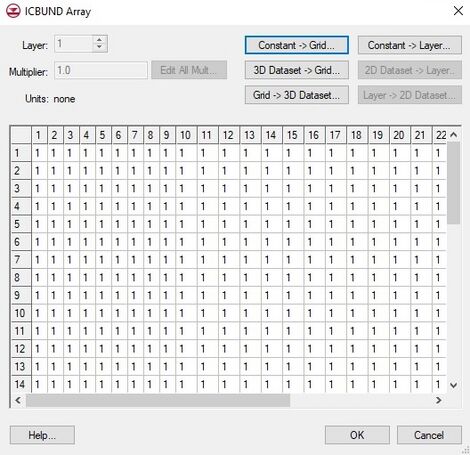GMS:ICBUND Array: Difference between revisions
| Line 19: | Line 19: | ||
===Cell Attributes Command=== | ===Cell Attributes Command=== | ||
In addition to directly editing the ICBUND array, another method for editing the ICBUND array is to select a set of cells and use the | In addition to directly editing the ICBUND array, another method for editing the ICBUND array is to select a set of cells and use the '''Cell Properties''' command in the ''MT3D'' menu. | ||
===Activate Cells in Coverage Command=== | ===Activate Cells in Coverage Command=== | ||
Revision as of 15:14, 22 July 2014
The ICBUND button in the Basic Transport Package dialog is used to enter the values of the ICBUND array. The MODFLOW Array Editor is used to edit the ICBUND array.
Values
The ICBUND array contains a value for each cell in the grid defining the type of the cell as either constant concentration, inactive, or variable concentration.
Constant Concentration
- A negative ICBUND value indicates that the cell has a constant concentration. The value of the constant concentration is defined in the starting concentration array described below.
Inactive
- An ICBUND value of zero indicates that the cell is inactive.
Variable Concentration
- A positive ICBUND value indicates that the cell has a variable concentration (i.e., the concentration will be computed as part of the simulation).
Initializing the ICBUND Array
The IBOUND array used by MODFLOW is similar (but not identical) to the ICBUND array. When a new MT3DMS simulation is initialized, the MODFLOW IBOUND array is used to initialize the values of the ICBUND array. Each cell which is designated as inactive in the IBOUND array is designated as inactive in the ICBUND array. Each cell which is designated as active (variable head) in the IBOUND array is designated as active (variable concentration) in the ICBUND array. Each cell that is designated as constant head in the IBOUND array is NOT designated as constant concentration in the ICBUND array. Rather, constant head cells are designated as active (variable concentration) in the ICBUND array.
Cell Attributes Command
In addition to directly editing the ICBUND array, another method for editing the ICBUND array is to select a set of cells and use the Cell Properties command in the MT3D menu.
Activate Cells in Coverage Command
If the Activate Cells in Coverage command in the Map module is used to change the active/inactive status of the cells, both the IBOUND and ICBUND arrays are updated accordingly.
Flow vs. Transport Inactive Zones
Since the computational domain of the transport simulation does not necessarily have to match the domain of the flow simulation, the active/inactive zones of the ICBUND array may differ from the active/inactive zones of the IBOUND array. In some cases, the active zone for a transport simulation is only a subset of the active zone of the flow simulation. Care should be taken, however, to ensure that any cells defined as inactive in the flow simulation are not defined as active in the transport simulation.
IBOUND vs. ICBUND Display
If a cell is designated as inactive, it is hidden when the grid is displayed, unless the Inactive cells option is selected in the 3D Grid Display Options dialog, in which case the inactive cells are displayed, but in a different color. If neither MODFLOW nor MT3DMS is in memory, the default 3D grid active/inactive flags are used to control the display of the grid. If MODFLOW is in memory, the active/inactive status of the cells as defined by the IBOUND array is used to display the grid. If both MODFLOW and MT3DMS are in memory, the ICBUND array takes precedence and is used to display the grid.
| [hide] GMS – Groundwater Modeling System | ||
|---|---|---|
| Modules: | 2D Grid • 2D Mesh • 2D Scatter Point • 3D Grid • 3D Mesh • 3D Scatter Point • Boreholes • GIS • Map • Solid • TINs • UGrids | |
| Models: | FEFLOW • FEMWATER • HydroGeoSphere • MODAEM • MODFLOW • MODPATH • mod-PATH3DU • MT3DMS • MT3D-USGS • PEST • PHT3D • RT3D • SEAM3D • SEAWAT • SEEP2D • T-PROGS • ZONEBUDGET | |
| Aquaveo | ||
